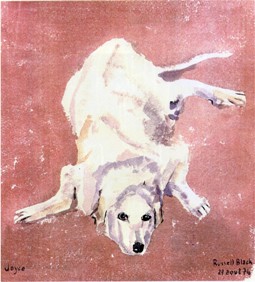
Then Russell undertook in 1970 a 4yr period as Overseas Professor of Geology in the Institute of African Geology, University of Leeds, seconded to the University of Addis Ababa, Ethiopia. According to his former students he painted regularly early in the morning before fieldwork for a better light. Unfortunately none of his Ethiopian paintings appear to have survived.
From 1974 until 1980 he was Head of a CNRS African geological research group in Montpellier at ‘Centre Géologique et Géophysique’ CGG. It was here that he focused the CGG on geological mapping of the eastern margin of the West African craton in the Adrar des Iforas, northern Mali, accompanied by his constant field companion, a white-coated Pyrenean mountain dog, Joyce (fig 5) who went everywhere in West Africa with him. From 1990 onwards, while based at the National Museum of Natural History in Paris, Russell went back regularly to his field areas in Aïr (fig 6), and the Proche-Ténéré (fig. 7) verifying his observations and writing major scientific papers. During this period he also painted extensively in France (fig 8 & 9), Italy (fig 10) for relaxation whilst on holiday with his wife, or in north Africa (fig 11) on his way back to France after a long winter field season examining the Tuareg Shield.
Read Russell Black's obituary